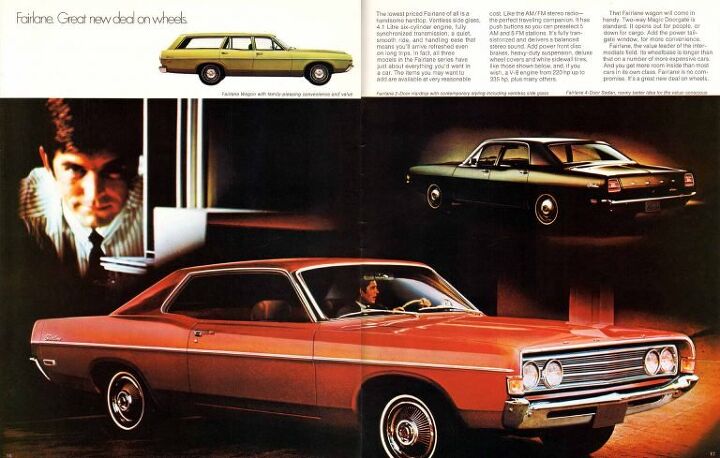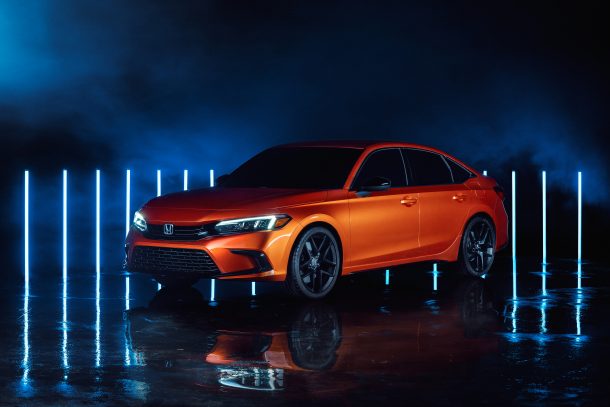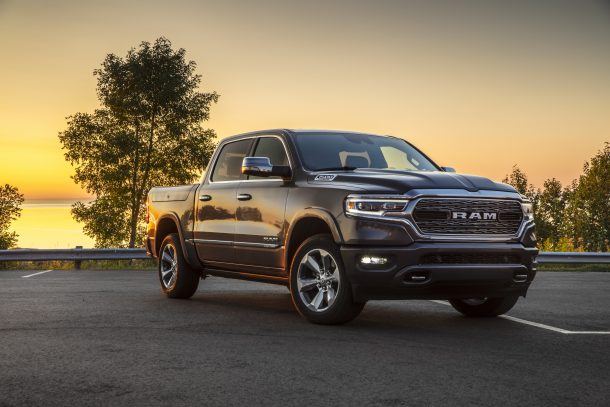#PassengerCars
We’re Poor and Drive Old Cars: Average Vehicle Age Continues to Rise
It seems most Americans are continuing to hang onto their cars for extended periods of time, with a new report suggesting the nation’s average vehicle age is 12.5 years. According to the crew at S&P Global Mobility, it’s the sixth straight year this number has increased.
Abandoned History: Ford's Cruise-O-Matic and the C Family of Automatic Transmissions (Part VI)
Abandoned History: Ford's Cruise-O-Matic and the C Family of Automatic Transmissions (Part V)
We resume our Ford Cruise-O-Matic transmission coverage today, as the original two- and three-speed automatics of the Fifties transition into the new C family. C transmissions were designed to be lighter (aluminum) and more efficient than their cast iron predecessors. The wonder of alloys!
In our last entry, we covered the first two C transmissions, the C4 (1964-1981) and C6 (1966-1996). Since we’re proceeding chronologically, we step back to Cruise-O-Matic for a moment, and a mix-and-match transmission: FMX.
Abandoned History: Ford's Cruise-O-Matic and the C Family of Automatic Transmissions (Part IV)
Last time on our Abandoned History coverage of Ford’s historical Cruise-O-Matic automatic transmission, we spent some time in Russia. Communist automaker GAZ liked Ford’s automatic and decided to lightly rework it into their “own” transmission rather than pay Ford to build it under license. The GAZ two- and three-speed automatics remained in use in the company’s passenger cars well into the Eighties, which was a very long time for a late Fifties transmission to live.
Shortly after GAZ made its copies, the real versions of the FX/MX Cruise-O-Matic and Ford-O-Matic were nearing the end of their respective service lives. The two-speed was naturally the first to go.
Abandoned History: Ford's Cruise-O-Matic and the C Family of Automatic Transmissions (Part III)
We pick up our Cruise-O-Matic automatic transmission coverage again today, as Ford’s first mass-produced gearbox found its stride in the Fifties. As consumers turned toward automatic transmissions in their two- and four-door domestic iron, they also turned toward more powerful V8 engines and big chrome bumpers and tail fins. Detroit’s manufacturers had to respond, and Ford’s answer was a second-generation Ford-O-Matic, the FX and MX. Both transmissions were marketed under the new Cruise-O-Matic moniker, while a new generation two-speed auto became the bargain basement Ford-O-Matic.
As we discussed in our last entry, in 1957 and 1958 Ford offered fiddly Keyboard Control. The whiz-bang new feature meant the Cruise-O-Matic was operated by confusingly marked dash-mounted buttons on select Mercury vehicles. And while Keyboard Control was limited to Mercury, an even worse version of the same idea was reserved for Edsel.
Abandoned History: Ford's Cruise-O-Matic and the C Family of Automatic Transmissions (Part II)
We continue our Abandoned History coverage of the Ford Cruise-O-Matic transmission today, shortly after the three-speed automatic established itself as a reliable motivation source for Ford, Lincoln, and Mercury products. Developed by the Warner Gear division of Borg-Warner, the new automatic caught Ford up to the competition as far as an automatic offering was concerned. Efficient and economical to build, Studebaker got in on the Cruise-O-Matic action for their cars too.
After the box proved itself on Ford and Mercury cars, it spread to the luxurious ’55 Lincoln lineup where it replaced the four-speed GM Hydra-Matic. We pick up there, as efforts got underway to improve upon the original Borg-Warner design and add whiz-bang features. This entry doesn’t end up where you’d expect.
Abandoned History: Ford's Cruise-O-Matic and the C Family of Automatic Transmissions (Part I)
As we finished up our coverage of General Motors’ Turbo-Hydramatic family of transmissions, I asked which gearbox you might like to see covered next by Abandoned History. The comments honed in on Ford, and the various versions of the C family of automatics. Fine by me! Today we head back to the Fifties to learn about the genesis of all the Cs. It was the extremely Fifties-sounding Cruise-O-Matic, built with pride in Cincinnati, Ohio.
2023 Vantas VX SUV and T-Go Coming to the U.S.
The Vantas VX SUV will go on sale in the U.S. in late 2022. HAAH Automotive Holdings and Sicar announced yesterday that they will import Vantas and T-Go vehicles. This is a prelude to HAAH and Shanghai Sicar Automotive Technology manufacturing vehicles stateside. The COVID-19 pandemic delayed their U.S. manufacturing startup.
We've Heard This Incorrect Forecast Before: Honda Believes in 2022 Civic Because "Passenger Cars Are Going to Stabilize"
As Toyota approached the launch of the all-new, 2018 Toyota Camry in mid-2017, the automaker telegraphed its intentions very plainly.
“I think you’re going to see the entire sedan market pick up,” then vice-president Jack Hollis said. “We want the new Camry to rehabilitate the segment,” Toyota’s Moritaka Yoshida said at the time.
Toyota wasn’t alone.
“I don’t expect to sell fewer Accords in 2018 with this great new product,” Honda’s sales vice-president, Ray Mikiciuk, said later on in 2017. Accord sales fell 10 percent in 2018 before sliding 8 percent in 2019.
One year later, Nissan’s Dennis Le Vot worked up to the launch of the 2019 Altima by suggesting that when it comes to passenger car market share: “We think 30 percent is the bottom.” Passenger car market share fell below 30 percent in 2019, the new Altima’s first full year.
Now we’re months away from the arrival of the 11th-generation Honda Civic. You know the drill: major automaker launches major car nameplate, major automaker suggests car market will stop the free-fall, major automaker hypes possibility of car market healing.
We’re skeptical.
QOTD: Will a Lincoln Car Ride Again?
Nearly two years ago we asked whether the resurgent Lincoln brand should just give up on passenger cars in favor of an all-SUV lineup. Back then, things were heading in the wrong direction for the two remaining Lincoln cars, the Fusion-based MKZ and the equally Fusion-reliant Continental. Fast-forward a couple of calendars and the situation has almost reached its inevitable conclusion.
The MKZ will bow out before the end of the year, and 2021 spells the end for the Continental’s brief return to the full-size luxury car segment. In this regard Lincoln is acting like Buick, though GM’s semi-premium marque stands to reach car-free status first. Can you envision a time when Lincoln finds it worthwhile to introduce a new passenger car?
August Brings Elevated Incentives, Higher Transaction Prices - But Not for Everyone
A flurry of new model additions benefitted many automakers with additional sales and greater revenue last month, and none more so than Fiat Chrysler, which saw its average U.S. transaction price rise 6.2 percent, year over year. Can you guess which segments pulled in the most extra money per vehicle? Bet you can.
At the other end of the yardstick, two foreign automakers basking in the glow of a very healthy sales month saw their average transaction prices fall.
Losers and a Few Winners: Here's the Cars That Bucked the Trend in 2018
Don’t worry, it isn’t a long list. You won’t be here all day. While the industry coasted to a surprising, yet slight, year-over-year volume increase in 2018, automakers can’t thank America’s desire for traditional passenger cars for eking out a win. Light trucks carried the day, with car sales plunging to new lows. Industry-wide, U.S. car sales sank 13.1 percent in 2018, pushing their share of the market to just over 31 percent.
Within this soup of sales, a handful of conventional passenger cars exist that held their ground, straining mightily against gale force headwinds. Maybe it’s a futile battle, but it’s worth noting these survivors.
More Bad News for Passenger Car Buyers
Flat new vehicle sales and an industry that’s far more interested in making crossover lovers’ dreams come true add up to a poor environment for a traditional new car buyer.
We’ve already told you how high demand for a shrinking supply of off-lease sedans and hatchbacks has sent used car prices through the roof compared to just a few years ago. That erased a go-to option for many thrifty buyers. In the new car market, however, automakers’ need to boost profits in a stagnant market means incentive spending is dropping as fast as used car prices are rising.
It’s not just sedans that saw a decline in discounts last month.
Low-priced New Vehicle Buyers Are Missing in Action
Once a bracket where most desirable vehicles lived, the sub-$20,000 price range is not the hot neighborhood it once was. The ever-upward creep of new vehicle MSRPs increasingly places most vehicles above that marker, and shifting consumer trends haven’t helped expand its ranks.
According to data from J.D. Power, 2018 has seen a rapid exodus from the cheap seats, with retail volume from the $20k-and-under crowd sinking 20 percent since the start of the year. Big spenders, on the other hand, are gobbling up $80,000-plus vehicles at a rapid clip.
Toyota and Honda Have Good Reason Not to Abandon Sedans
Ford’s already brought the axe down on all but one of its car models, and General Motors looks ready to do the same. Other automakers, however, know that ditching sedans would mean abandoning key groups of customers.
For Toyota and Honda, models like the Camry and Civic resonate far more among some demographics, and leaving that segment risks losing those buyers to other brands. Not everyone wants a crossover. Among Asians, Hispanics, and African-Americans, four Japanese nameplates keep popping up at the top of the most-bought list, but one domestic model poses a growing threat.






























Recent Comments